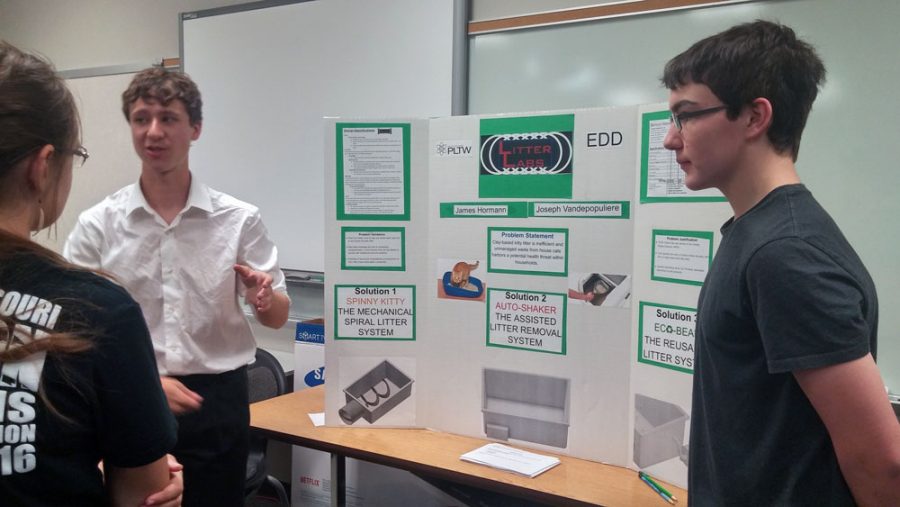The two day gallery walk at the Columbia Area Career Center (CACC) that showcased the Engineering Design and Development classes’ real world problem-solving projects ended today. The purpose of the course is for the students to pick a problem and use the knowledge they’ve learned in previous engineering courses to find a solution for it. The course’s teacher, Jim Kyd, said the project highlights applicable issues and skills needed for a career in engineering or related fields.
“What the gallery walk does is it allows other people to look at [their projects and] give their opinions. They’re trying to come up with real data from the insight from other people. Yesterday, it was all adults with engineers and professionals. Today it’s a lot of students [visiting],” Kyd said. “They get it to where they have the solution and that’s the end of the first third. The middle third is [where] we actually build a working prototype. Then the final stage is build the prototype and test it. This is really the first time they’ve ever had a project that went eight months, so this is literally what you would do in the real world.”
Senior Adam Cox-Irvin, whose project aims to solve the problem of wireless charging, said he and his partner’s presentation today and yesterday was a success.
“What we are making is a universal wireless charger that will work for both Apple and Samsung and will have no wires that will also have a radius in which you can walk around and use your phone while it charges,” Cox-Irvin said. “We had lots of people, many [of which] thought our ideas were great.”
[quote cite=”Jim Kyd”]At the very end of the year they’ll make a 30 minute presentation in front of a board of engineers and education people. They would present it as if these people are prospective investors.[/quote]
Battle High School junior Katie Visalli and her partner chose to do their assignment based on their essential question “Hair is difficult to clean up off the floor by existing means.” Their three solutions included a design where the hair fell through a mesh pad, was pick up by a large lint roller and newly designed vacuum.
“This problem was actually brought to us by a local barber in town because [we didn’t like any of the] problems that were left that other people had voted on,” Visalli said. “We would team up with barber salons here in Columbia and give them the prototype and then have them take notes on how well it’s working and give feedback to us to see how we need to change it to make it better.”
This is the second year the CACC has hosted the gallery walk, which Kyd said operates under the Project Lead The Way (PLTW) initiative. Unlike some programs in PLTW, he said the students in his class learn through project based education that is applied throughout the year. Kyd said at the end of the year when the students have tested their prototype, the final for the class includes a presentation that sums up the work they’ve done throughout the year.
“At the very end of the year they’ll make a 30 minute presentation in front of a board of engineers and education people. They would present it as if these people are prospective investors. They’ll show the data [and] say what it costs for a pre-production prototype. After the presentation they’ll come back and we’ll do a reflection where I ask [them] specific questions for them to answer. [The project] takes the whole year.”

“So far I’ve loved it [because of] the independence of our work and the classroom environment,” Cox-Irvin said. “Time management [is the most difficult aspect]. You and your partner have to work as a team and know when to tackle things as a team versus tackling things independently.”
Kyd said all the students have not only worked well with their partners, but also with the rest of the class in supporting their ideas and providing feedback.
“This is a great group of students. Every one of those students is totally into it because they picked their problem; they’ve become experts about their problem,” Kyd said. “The way the class is, the whole class is the company, so we’re all there to help each other. The teams of two are basically design teams within the company. They really enjoy watching other people’s [projects progress] as well as their own.”
all photos by Grace Vance
Did you attend the gallery walk? What did you think? Leave a comment below!














































































Jadyn Lisenby • Nov 5, 2016 at 5:29 pm
This seems like a fun event for students to present their own ideas to others. A lot of the ideas for inventions in this article are interesting and will probably be a helpful invention after working on the project for a year.
Jordan Rogers • Nov 4, 2016 at 12:55 pm
I think this is a great opportunity for aspiring engineer students, and students in lower levels of engineering like IED. It’s so cool how high school students can come up with such innovative ideas
Alexis Walker • Nov 3, 2016 at 8:40 pm
I think it is really interesting and inspiring that high school students are creating things that could actually benefit the people of the world. I think it is great that younger people are inventing things too. Older people aren’t the only people that can make something worthwhile.